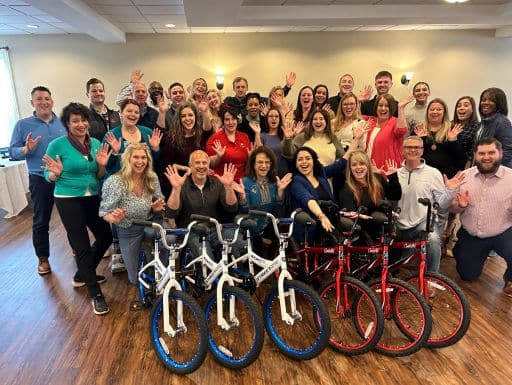How to Improve Teamwork and Communication to Create a High-Performing Team

These five strategies and insights will help make collaboration and communication the cornerstone of your team:
- Establish Clear Goals and Roles to Help Everyone Stay Focused on a Common Objective
- Foster Open Communication so People Feel Comfortable Expressing Their Thoughts, Ideas, and Concerns
- Use Collaboration Tools to Ensure Everyone is on the Same Page
- Provide Regular Feedback to Identify Areas for Improvement and Facilitate Growth
- Invest in Team Building Activities to Build Trust, Foster Collaboration, and Improve Morale
Read on to learn more!
1) Establish Clear Goals and Roles to Help Everyone Stay Focused on a Common Objective

Tom was convinced that success would come naturally, and he didn’t believe in setting goals. Jerry, on the other hand, was a goal-setter who decided to set clear objectives for his business.
After a few months of working on their businesses, they hit some inevitable roadblocks. Tom struggled to stay on course and wasn’t making much progress. Jerry had a specific set of goals to focus on.
As a result, Jerry was able to take focused action, stay motivated, and measure his progress regularly. He tracked his sales, marketing efforts, and product development, and made adjustments along the way. Tom, however, struggled to stay focused and became easily discouraged when things didn’t go as planned.
Unsurprisingly, Jerry’s business was still thriving after a year. He’d had his tough times, of course, but his goals kept his priorities in check. Tom was not able to weather the storms and had to shut his business down. When tough times hit, he didn’t have any goals to align his efforts to, so his actions were unfocused and ultimately unproductive.
If You Don’t Establish a Common Goal, Your Team Will Be Lost
To prevent members of your team from becoming like Tom, it’s essential that business leaders establish their team’s roles and what they should be striving for. Here’s why doing this part right makes all the difference to help improve teamwork and communication:
- Every role can maximize its strengths: Every role is different, but with a common set of goals, everyone will know what to work toward. As experts who take ownership in their jobs, they’ll be able to figure out how to achieve that success using their unique skill sets.
- There will be less confusion and conflict: If there’s no clear vision for success, everyone will hold different perspectives on how to do things best. This will make collaboration a nightmare. Likewise, if roles aren’t clearly established, team members won’t know who to turn to when they need help.
- No room left for micromanaging: Do you or your managers have issues with delegating? Do you find yourself checking in on subordinates too often? It could be due to a lack of clarity in goals and roles, and that could be creating issues with trust (more on that in the last section).
Choose Goals That They Can Envision
In order to get your team jazzed about goals, they have to be able to envision them. Natalie Dawson of Cardone Ventures, in her book TeamWork, writes about a method for goal setting that she recommends every organization should use.
Dawson advises that managers have all individual team members create personal, professional, and financial goals for the next one, three, and five years. PPF goals should be discussed at every one-on-one meeting, and managers should do what they can to help their employees reach those goals.
Here’s what her first set of PPF Goals looked like from when she was twenty years old:
Personal:
- Find supportive friends
- Eat one green thing every day
Professional:
- Be a manager and lead a team
- Travel monthly for work
Financial:
- Save $5K to put down in order to buy a nicer car
- Make $15 per hour
Dawson advises that you don’t skip the personal goals section, as personal goals can often be deeply tied to professional and financial goals (why go to work or start a business if not to make our personal lives better?).
2) Foster Open Communication so People Feel Comfortable Expressing Their Thoughts, Ideas, and Concerns

Good communication is like a well-tuned orchestra. Each member of the orchestra has a specific role and instrument to play, but they have to work together in harmony. If not, they won’t be able to create beautiful music.
Similarly, in good communication, each person has a unique perspective and voice to contribute. However, they must work together and actively listen to each other to be successful.
Likewise, a good conductor must act as the leader to guide the orchestra and ensure that every voice is heard. When everyone levels up in this skill, it goes a long way to help improve teamwork and communication
Failure to Communicate Leads to Failure in Business
What would you say is the biggest reason that corporations run into errors? As you may have guessed given the title of this subheading, the answer is poor communication. Not incompetence or unskilled workers, but simply poor communication is the reason for 70% of corporate errors.
Unclear instructions and not listening to each other’s input is a large factor in making errors. To better illustrate that point, let’s look at some of the problems created by poor communication:
- Misunderstandings turn into unnecessary problems: This can be exacerbated when members of a team stick to only one form of communication, such as email or text, instead of picking up the phone or meeting face-to-face in an office.
- Performance dwindles under poor communication: When employees are not sure about what’s expected of them or do not receive the instructions they need, it leads to a drop in productivity.
- Cooperation fails when employees don’t communicate together: If employees don’t understand each other’s views or personality types, efforts to collaborate can fail (and that will discourage them from trying again).
Take Responsibility to Encourage Good Communication
Just like in the analogy of the orchestra, you can’t expect the musicians to play in sync without a leader. You can help improve teamwork and communication by facilitating good communication with:
- Regularly scheduled one-on-one meetings: Don’t skip out on these meetings just because everything seems OK! Use these opportunities to hear your employees’ concerns, feedback, or ideas.
- Anonymous feedback: Surveys, suggestion boxes, or web apps are a great way to capture anonymous feedback. Use whichever method is best to make your employees feel that they can express their thoughts without fear of retaliation.
- Employee forums and town hall meetings: These can be done either in person or in a virtual setting. At these team meetings, leaders can give updates and speak their minds to the whole company. Members of the team can take turns asking questions or submitting them in a web form.
- Conflict resolution training: Managers and employees can both benefit from these types of trainings. Learning how to manage disagreements constructively can go a long way in building relationships and better communication.
- Developing a culture of open communication: To open communication lines further, find ways to start ingraining it in the culture, such as by making it a core value or openly rewarding it.
3) Use Collaboration Tools to Ensure Everyone is on the Same Page

Just as you wouldn’t use a hammer to tighten a bolt, you must choose the right forms of communication for each situation.
For example, to convey complex information, an organized email or detailed presentation will work better than sending a wall of rapid-fire Slack messages. And if you need to give feedback, a face-to-face conversation or a phone call will lead to a more productive conversation than an email would.
Using the wrong building tool can cause frustration and damage your building materials. Likewise, using the wrong communication style can lead to confusion, misunderstandings, and strained relationships. If you select the appropriate communication tool for each situation, you can vastly improve teamwork and communication.
It’s Not About More Communication Tools, It’s About the Right Ones
With the boom in communication and productivity software in recent years, it’s tempting to see each one as a solution to a given problem. The issue that brings, however, is an overload of information and a heap of confusion. If you have several tools with overlapping communication features, no one will know which ones to use. At the same time, employees feel like they’re obligated to use all of the tools that their company has provided.
The truth is that constant communication can be a detriment. In fact, a survey found that 74% of employees say they spend most of their day looking at their computer, phone, or tablet. This leads to digital overload, which contributes to wasted time, attention, and energy on unnecessary interactions. Remote teams and in-person teams, alike, can suffer from these problems.
Instead of finding more communication tools for your team, try to pin down the one that will work best. Then, establish the correct culture on how to use them. That means setting rules such as:
- When email should be used over instant messaging, or when a meeting should be scheduled instead of an impromptu phone call
- Whether or not it’s appropriate to text personal phones about work matters
- Official communication channels for requests or questions to a certain department
Collaboration Tools that Can Help Employees Do More and Say Less
A good collaboration tool can go a long way in helping improve teamwork and communication. For example, instead of having to ping someone to get a status update on a project, the right software can communicate all that information on its own. Here are some examples of web apps that may work for your business. But remember to research your options, keep it limited to as few tools as possible, and ensure all the relevant employees are trained on how to use it:
- Notion: An all-in-one workspace for managing projects, taking notes, creating wikis, calendars, and more.
- Trello: Project management software that uses boards, lists, and cards to organize tasks. It’s great for taking your workflows from start to finish in an easy-to-use and intuitive interface.
- Monday.com: A visual project management system that allows every member of the team to track their work and collaborate on projects in real time. It’s designed to help teams manage complex projects and workflows.
- Asana: Helps teams organize, track, and manage their work in one place. It has features like task assignments, due dates, and subtasks. It can also be integrated with Slack and Gmail.
- Airtable: For data-heavy teams, Airtable can help you organize and manage your data in flexible and collaborative ways. It can be used for project management, CRM, and content management.
4) Provide Regular Feedback to Identify Areas for Improvement and Facilitate Growth

The truth, however, is that’s simply not how the majority of employees see feedback. According to participants of a survey, employees don’t just want feedback—they feel like they don’t get enough of it:
- 75% of employees feel the feedback they receive is important for their work
- 45% of respondents value feedback from peers and clients
- Less than 30% said they actually receive feedback
Feedback is a vital part of employee satisfaction. The more often you and your team practice giving feedback to each other, the more it will help to improve teamwork and communication.
Neglecting to Give Feedback Creates a Toxic Culture
Gary Vaynerchuk is known for coining the concept of “kind candor.” In the simplest terms, it means being both truthful and kind in your feedback to your team members.
In a blog post on the subject, Gary admits to us that giving truthful feedback to his employees was one of his biggest weaknesses and that it was becoming toxic for his company.
Instead of being open and honest, Gary was doubling down on only providing kindness to his employees. In turn, their opportunities for improvement were never addressed. The bad behaviors would repeat until Gary had no choice but to “surprise-fire” them once he couldn’t handle it anymore. This ended up creating a culture of fear at his office, as people began to feel like they might get fired at any moment.
If you neglect to give honest feedback, you’ll create resentment toward the people you work with. Not only that, but it will also cause employees to become complacent and they will lack accountability for themselves.
How Great Leaders Give Better Feedback
Now that you know the importance of giving constructive criticism to help improve teamwork and communication, here’s how to do it:
- Be specific: Avoid any vague or general comments. Keep your feedback clear and specific so that there’s no ambiguity.
- Be objective: Whenever possible, give feedback based on observable and measurable criteria. Find examples of work that fails to meet the established standards. Without examples or data, your feedback may come off as a criticism of their character.
- Be timely: Provide feedback as soon as possible after the behavior or action occurs. You want the details to still be fresh in everyone’s mind.
- Offer solutions: Always come prepared with solutions. Although being timely is important, take time to think of some possible solutions before delivering your feedback.
5) Invest in Team Building Activities to Build Trust, Foster Collaboration, and Improve Morale

“Above all, success in business requires two things: a winning competitive strategy, and superb organizational execution. Distrust is the enemy of both. I submit that while high trust wont necessarily rescue a poor strategy, low trust will almost always derail a good one.”
So while building a team culture of high trust won’t necessarily boost your profits, a culture of low trust will contribute to a steady decline.
Distrust in your team’s culture is like a disease. The team can still function in the day-to-day operations, but the symptoms of the disease will get worse and worse
- Lack of communication
- Micromanagement
- Blame-shifting
- Lack of engagement
- Resistance to change
- Silos and factions
Likewise, there’s plenty of evidence to back up the legitimacy of this “disease.” Research from MIT Sloan shows that trust is a critical driver of engagement. Trusting employees are:
- 260% more motivated to work
- 41% less likely to engage in absenteeism
- 50% likely to look for another job
On the other side of this coin, however, the research found another shocking statistic: most employers overestimate their workforce’s trust level by nearly 40%.
This could mean that employers won’t make efforts to build trust because they don’t think their team needs it! As you can imagine, you won’t be able to improve teamwork and communication without a strong foundation of trust.
How Team Building Activities Boost Trust
Ultimately, the best way to make a significant improvement in trust is to ingrain it into the culture. In order to set the precedent for that change, however, you might need something to flip the script. Team building activities are the perfect way to do that, and here’s how:
- They establish trust: Good team building activities will create an environment for open communication, active listening, and mutual respect. This will help the entire team feel more comfortable sharing their ideas and opinions.
- They encourage collaboration: In the day-to-day role, your team members may not have many opportunities to collaborate with others outside of their closest colleagues. Team building activities get the whole group together to engage in cooperation and teamwork in ways they never have before. This, in turn, fosters a sense of unity and shared responsibility.
- They boost morale: When you get employees working on a fun goal together, you have the chance to show them what it’s like to work in a positive work environment. Showing them that they’re capable of this positivity among coworkers can help increase motivation and job satisfaction when it comes time to reconvene back at the office.
- They improve problem-solving skills: Good team building exercises require not just teamwork skills, but out-of-the-box thinking. As they complete tasks, employees will learn how to improve their problem-solving skills, think creatively, and strive for innovation. These traits will not only create a more productive team, team members will also achieve greater satisfaction when performing their best.
- They strengthen relationships: Overall, team building activities will create opportunities for diverse teams to get to know each other better, build rapport, and develop deeper connections. This will help create a more cohesive team that can depend on each other.
The Keys to Improve Teamwork and Communication
Building a successful team requires intentional effort and investment from all members. You can do this by establishing clear goals and roles that help everyone stay focused on a common vision of success. To pave the groundwork for continued trust, however, you’ll need to foster open communication (just make sure you’re using right kinds of communication tools). Regular feedback will give team members areas for improvement so they don’t stay complacent. And in order to set the precedent for what trust and communication looks like, teamwork training and team-building activities can help set the tone. All together, these factors can help teams work together effectively, achieve their goals, and build a strong and supportive workplace culture.
